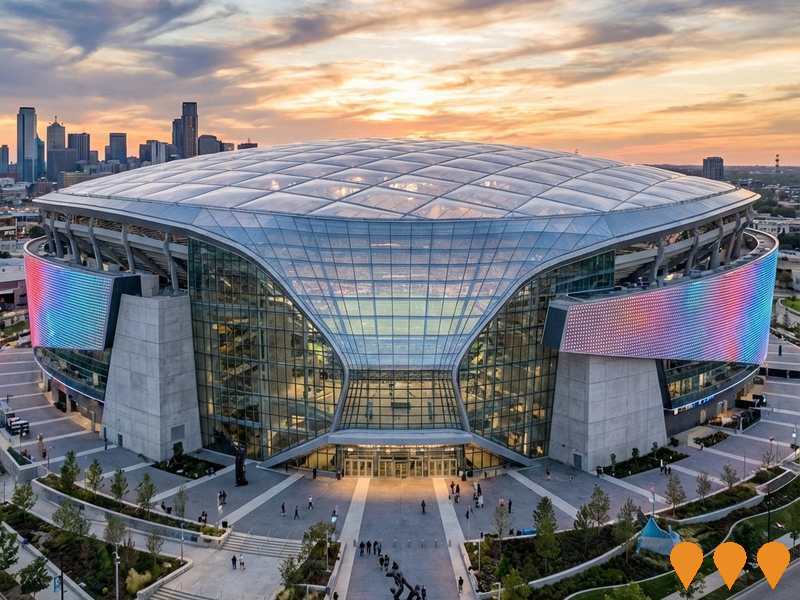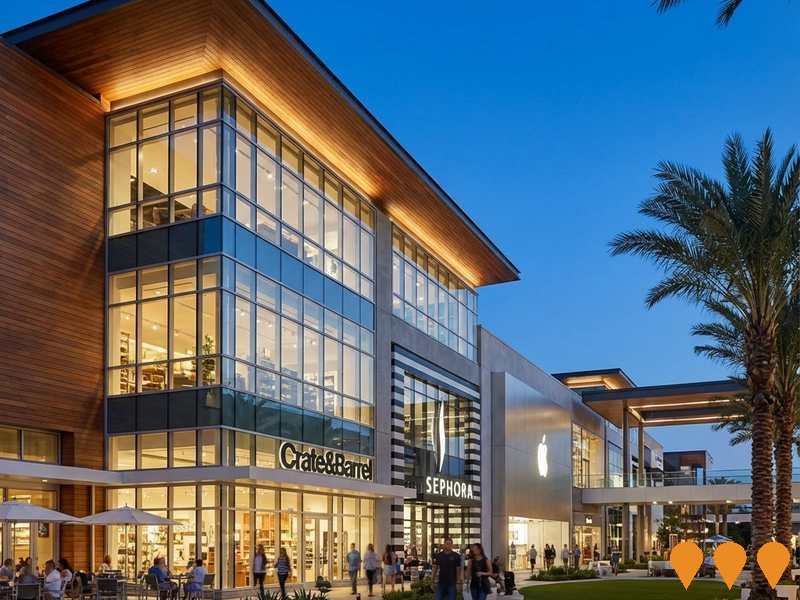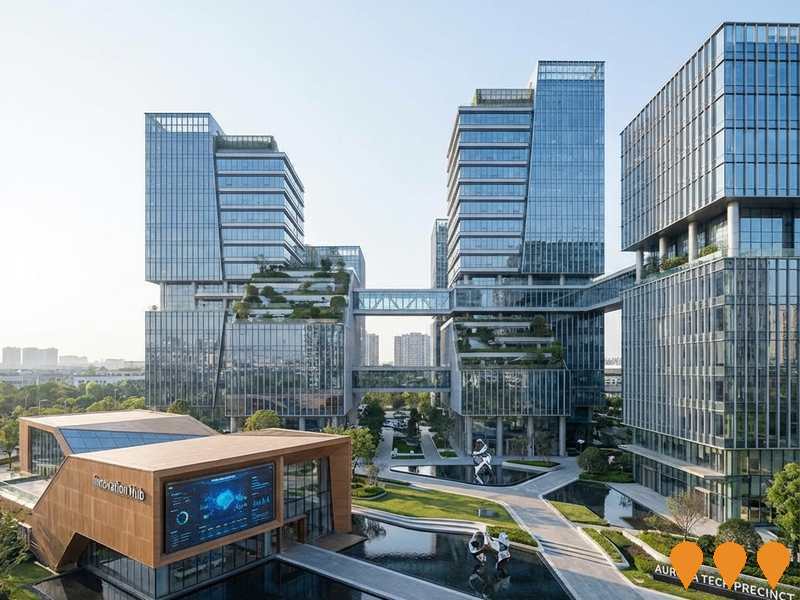Chart Color Schemes
est. as @ -- *
ABS ERP | -- people | --
2021 Census | -- people
Sales Activity
Curious about local property values? Filter the chart to assess the volume and appreciation (including resales) trends and regional comparisons, or scroll to the map below view this information at an individual property level.
Find a Recent Sale
Sales Detail
Population
An assessment of population growth drivers in Armidale reveals an overall ranking slightly below national averages considering recent, and medium term trends
Armidale's population was around 24,796 as of August 2025. This figure reflects an increase of 829 people since the 2021 Census, which recorded a population of 23,967. The growth is inferred from ABS estimated resident population data of 24,410 in June 2024 and validated new addresses since the Census date. This results in a population density ratio of 90 persons per square kilometer. Armidale's growth rate of 3.5% since the 2021 census exceeded the SA3 area average of 3.3%. Overseas migration contributed approximately 80.1% of overall population gains during recent periods.
AreaSearch uses ABS/Geoscience Australia projections for each SA2 area, released in 2024 with a base year of 2022. For areas not covered by this data, NSW State Government's SA2 level projections are used, released in 2022 with a base year of 2021. Growth rates by age group from these aggregations are applied to all areas for years 2032 to 2041. Based on projected demographic shifts, Armidale is expected to increase by just below the median rate of Australia's non-metropolitan areas, reaching a population of 26,715 by 2041 with an overall increase of 6.1% over 17 years.
Frequently Asked Questions - Population
Development
Recent residential development output has been above average within Armidale when compared nationally
Armidale has averaged approximately 120 new dwelling approvals annually over the past five financial years, totalling 601 homes. As of FY-26, 36 approvals have been recorded. Despite population decline, housing supply has remained adequate relative to demand, resulting in a well-balanced market with good buyer choice. The average expected construction cost of new homes is $374,000, below the regional average, suggesting more affordable housing options for buyers.
This financial year has seen $19.6 million in commercial approvals, indicating moderate levels of commercial development. Compared to Rest of NSW, Armidale exhibits moderately higher building activity, with 22.0% above the regional average per person over the past five years. The dwelling approval mix shows 45.0% detached dwellings and 55.0% medium and high-density housing, marking a significant shift from existing patterns (currently 82.0% houses). This may indicate diminishing developable land availability and respond to evolving lifestyle preferences and housing affordability needs. Armidale has approximately 121 people per dwelling approval, suggesting a low density market.
Future projections anticipate an increase of 1,509 residents by 2041. At current development rates, new housing supply is expected to comfortably meet demand, providing good conditions for buyers and potentially supporting growth beyond current population projections.
Frequently Asked Questions - Development
Infrastructure
Armidale has emerging levels of nearby infrastructure activity, ranking in the 29thth percentile nationally
Changes to local infrastructure significantly influence an area's performance. AreaSearch has identified 17 projects likely impacting the area. Notable ones are Armidale East Mall Revitalisation, New England Renewable Energy Zone (REZ), Social Housing Development Initiative - Armidale, and Armidale Retail Precinct Expansion. The following list details those most relevant.
Professional plan users can use the search below to filter and access additional projects.
INFRASTRUCTURE SEARCH
 Denotes AI-based impression for illustrative purposes only, not to be taken as definitive under any circumstances. Please follow links and conduct other investigations from the project's source for actual imagery. Developers and project owners wishing us to use original imagery please Contact Us and we will do so.
Denotes AI-based impression for illustrative purposes only, not to be taken as definitive under any circumstances. Please follow links and conduct other investigations from the project's source for actual imagery. Developers and project owners wishing us to use original imagery please Contact Us and we will do so.
Frequently Asked Questions - Infrastructure
New England Renewable Energy Zone (REZ)
Australia's largest declared Renewable Energy Zone with a network capacity of 8 GW. Supports large-scale wind, solar, storage and emerging energy projects backed by new transmission infrastructure. Expected to attract approximately A$24 billion in private investment and create around 6,000 construction jobs and 2,000 ongoing operational jobs across the New England region.
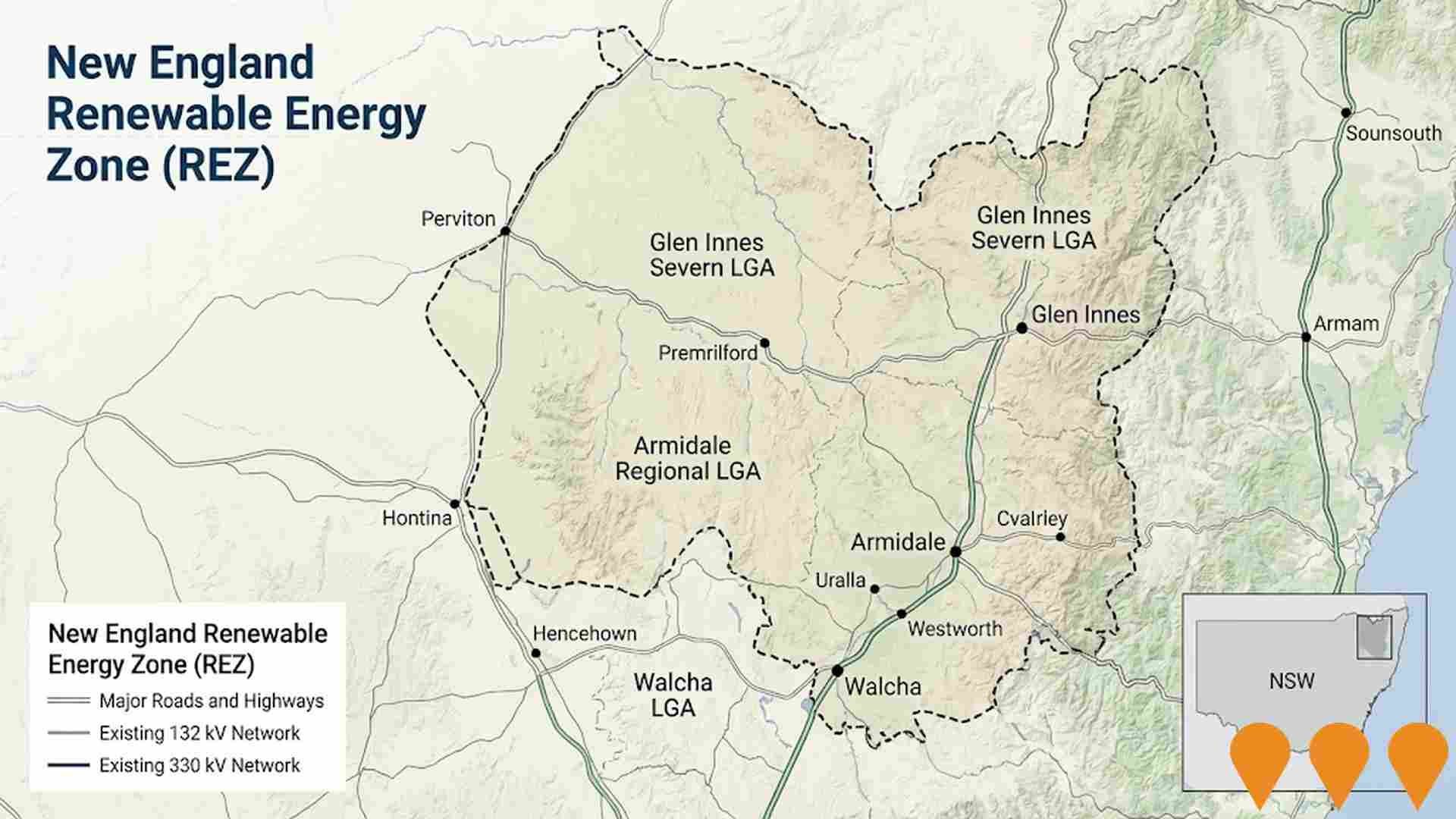
Armidale Hospital Redevelopment
The redevelopment of Armidale Hospital included a new emergency department, surgical suites, maternity services, and patient accommodation. It enhances healthcare capacity for the New England region, serving over 50,000 residents.
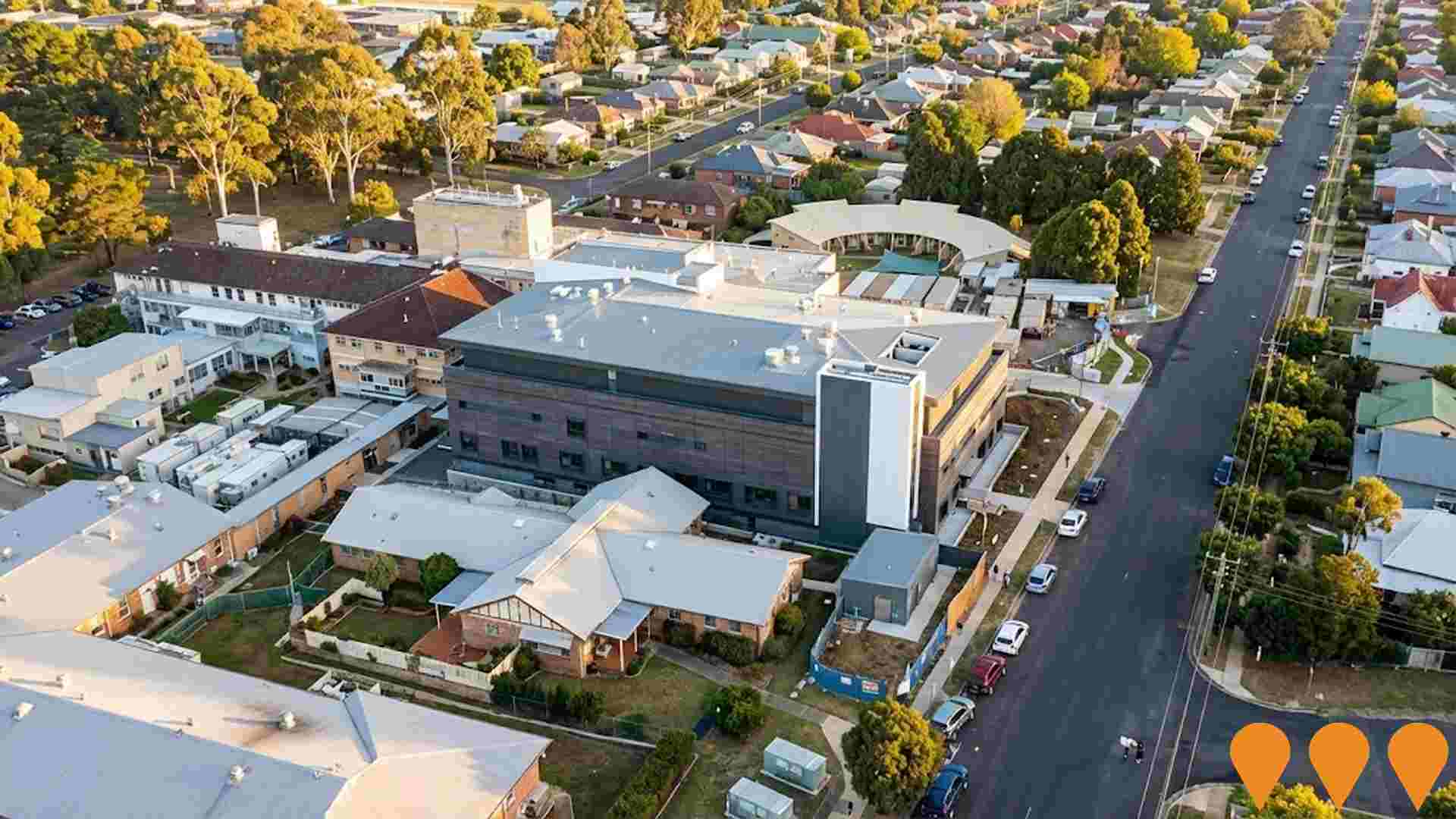
Armidale East Mall Revitalisation
A comprehensive revitalisation project to transform the East Mall section of Beardy Street into a vibrant public space. The project includes flexible/shared spaces, improved vehicular and pedestrian access, increased parking from 15 to 36 spaces (including disabled spaces), new street furniture, improved lighting, WiFi, CCTV, landscaping, outdoor dining opportunities, bicycle parking stations, car/bike charging stations, raised pedestrian intersections, tree plantings, potential public art, and heritage-sensitive design elements. Detailed concept plans were endorsed by Council in May 2024; Council is seeking grant funding for detailed design and construction.
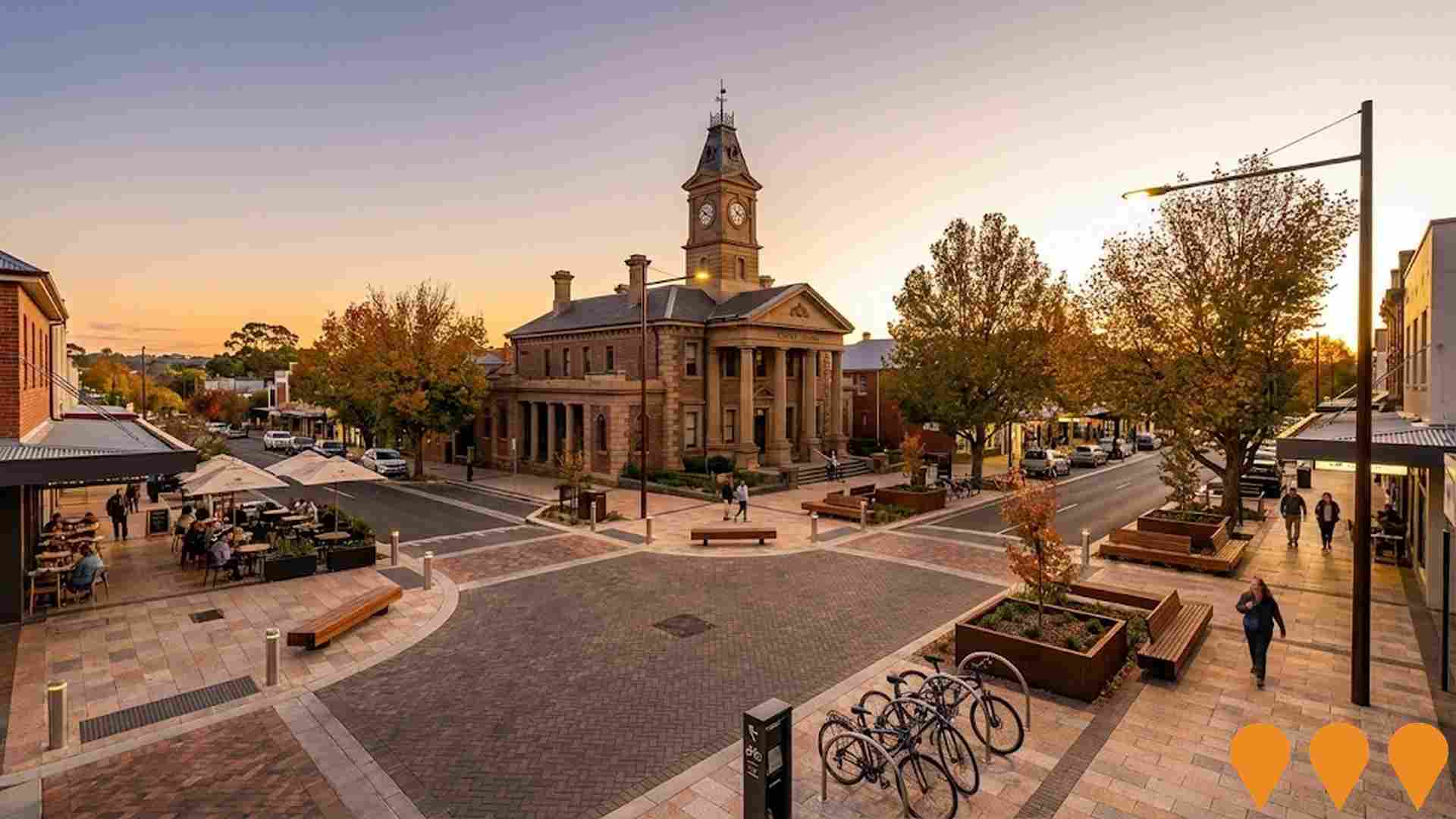
Armidale Secondary College
A completed $121 million state-of-the-art secondary school that combines Armidale High School and Duval High School. The campus accommodates approximately 1,500 students and features 79 modern learning spaces, specialist facilities for science, industrial arts, hospitality, performing arts and agricultural studies, a multipurpose hall, and restored heritage buildings. The college opened in 2021 and represents the largest education investment in regional NSW.
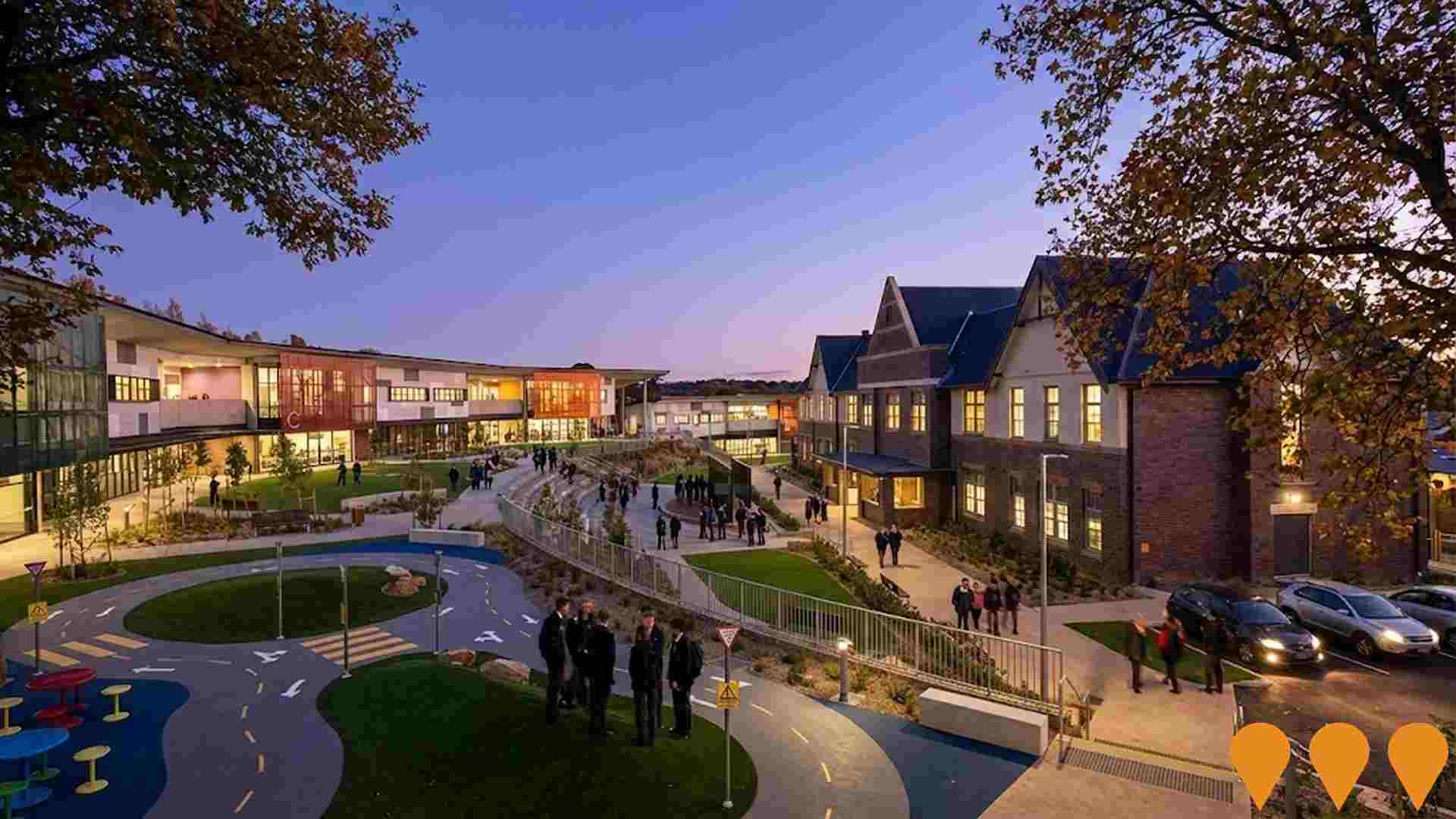
Armidale Plan 2040
Council-adopted strategic land use framework guiding growth of the Armidale Regional LGA to 2040; aligns with the New England North West Regional Plan 2041 and supports subsequent local strategies (e.g., LSPS 2024).
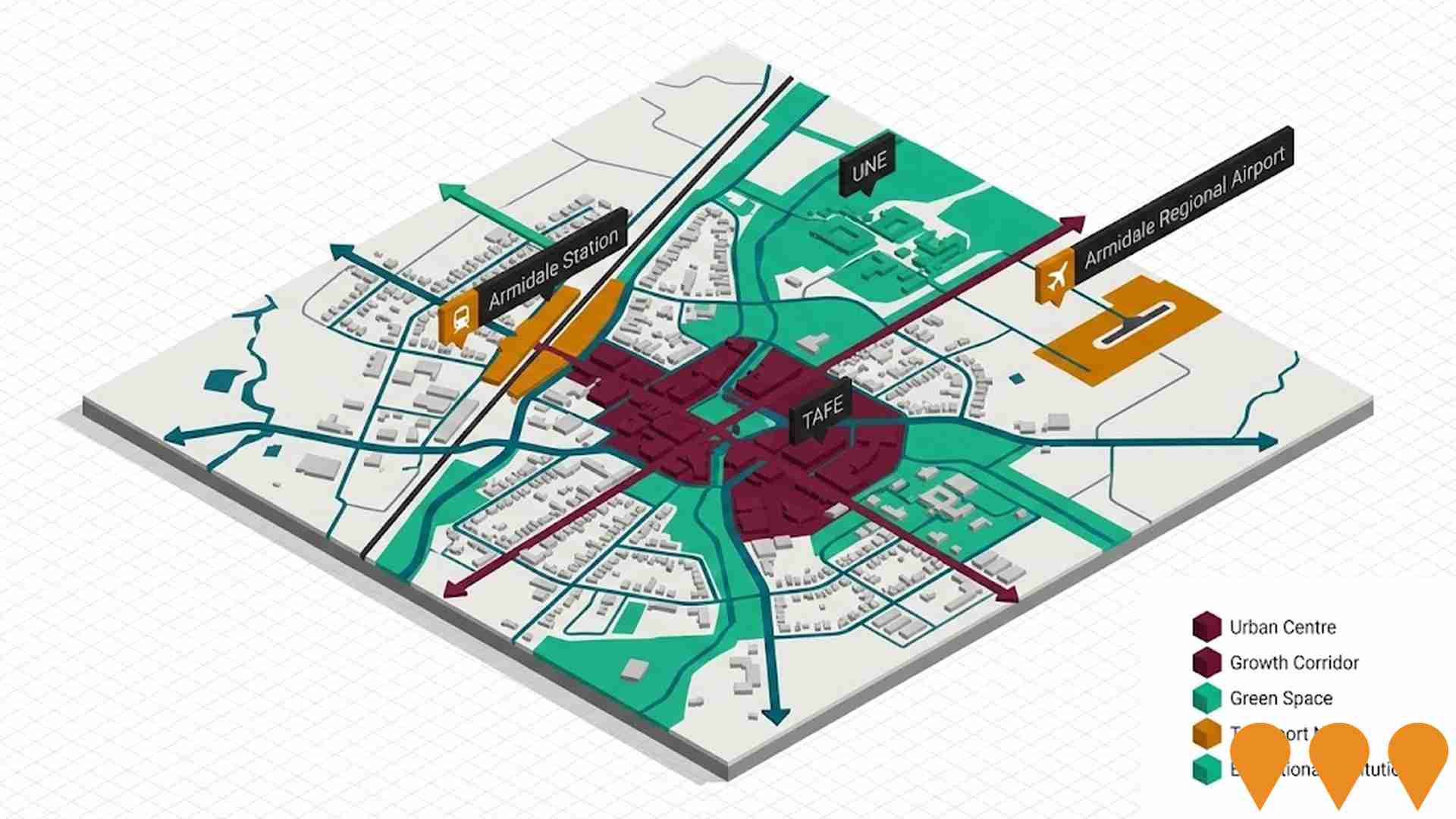
Social Housing Development Initiative - Armidale
Council-led EOI to enable delivery of new social housing on council-owned land in Armidale, aligning with the 2024 Local Strategic Planning Statement and Local Housing Strategy. Delivery partner expected to be Homes NSW and/or community housing providers. Program-scale initiative focused on increasing supply of fit-for-purpose social dwellings for vulnerable residents.
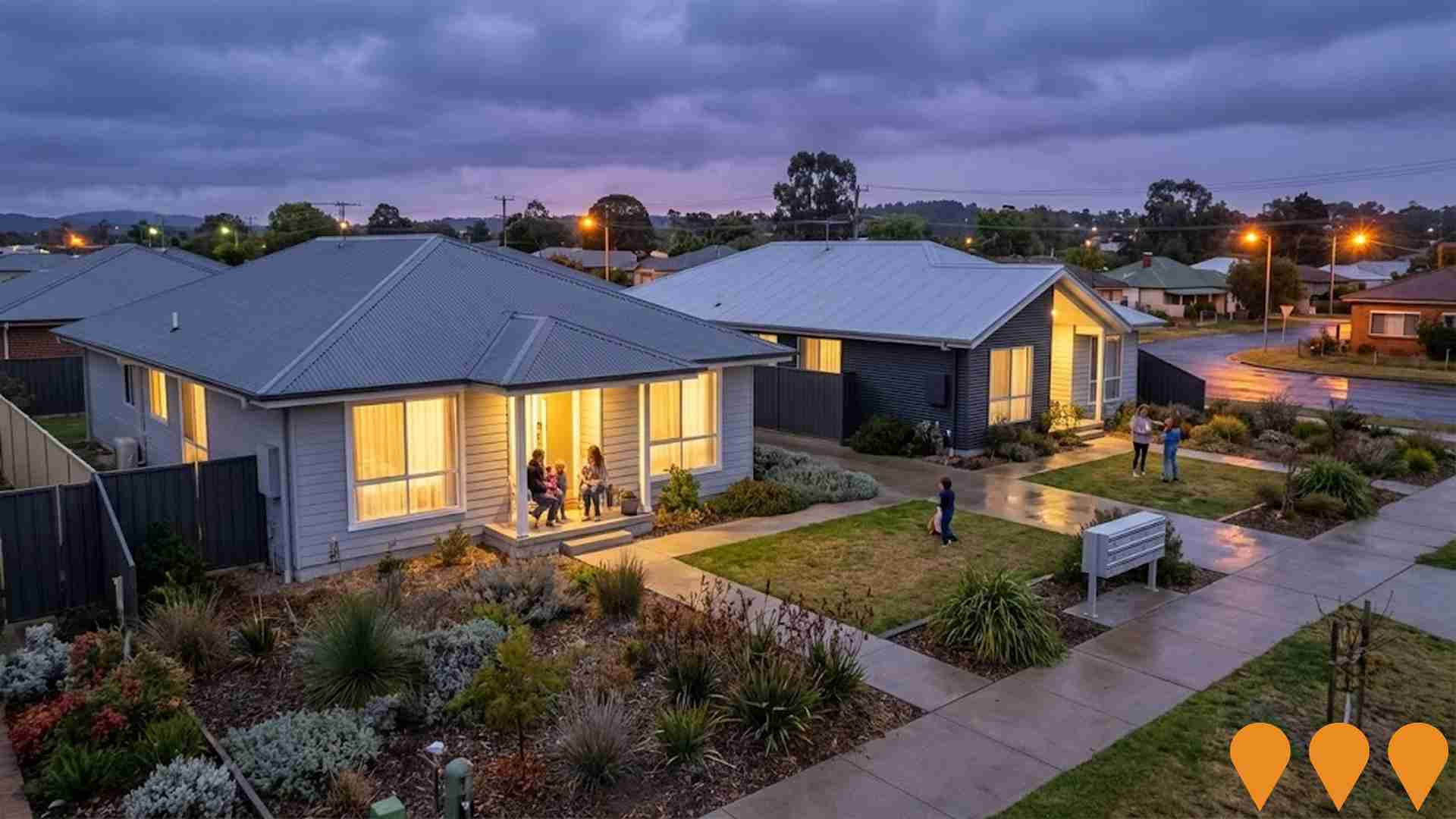
UNE Campus Master Plan 2017-2035
The University Campus Master Plan 2017-2035 aims to unify the Armidale Campus through rejuvenated academic, residential, commercial, and sporting precincts. It focuses on fostering interaction among academics, researchers, and students with digitally dominant e-learning facilities and environmentally sustainable practices. Key features include new service corridors for smart microgrid management, reduction of electricity demand, increase in on-site renewable energy, transport upgrades, landscape infrastructure, and upgrading existing infrastructure.
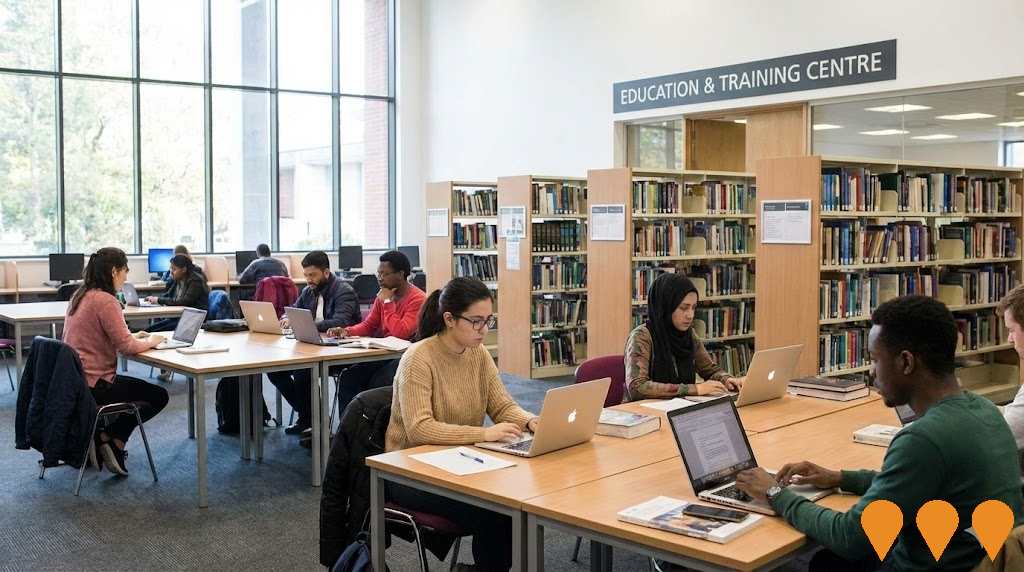
Armidale Regional Local Housing Strategy
The Armidale Regional Local Housing Strategy is a 20-year plan adopted on August 6, 2024, to guide housing delivery in the Armidale region, aiming to provide 4,400 new dwellings to accommodate an additional 10,000 residents by 2043. It focuses on increasing housing diversity, density, affordability, and sustainability while aligning with infrastructure and community needs. As of March 2025, the council is seeking expressions of interest for developing council-owned land for social housing.

Employment
Employment conditions in Armidale demonstrate strong performance, ranking among the top 35% of areas assessed nationally
Armidale has a well-educated workforce with an unemployment rate of 2.6% as of June 2025. This is 1.1 percentage points lower than the Rest of NSW's rate of 3.7%.
The area had an estimated employment growth of 3.9% over the past year, with 13,674 residents employed. Key industries include education & training, health care & social assistance, and retail trade. Education & training is particularly specialized, with an employment share 2.3 times the regional level. However, construction is under-represented at 6.9% compared to Rest of NSW's 9.7%.
Many residents commute elsewhere for work based on Census data. In the 12-month period ending June 2025, employment increased by 3.9%, labour force grew by 3.2%, and unemployment fell by 0.6 percentage points. By comparison, Rest of NSW saw employment decline by 0.1%, labour force growth of 0.3%, and unemployment rise by 0.4 percentage points. National employment forecasts from Jobs and Skills Australia, released in May 2025, project national employment growth of 6.6% over five years and 13.7% over ten years. Applying these projections to Armidale's employment mix suggests local growth could be approximately 6.6% over five years and 13.7% over ten years.
Frequently Asked Questions - Employment
Income
Income levels sit below national averages according to AreaSearch assessment
Armidale's median income among taxpayers was $48,389 in financial year 2022. The average income stood at $60,875 during the same period. These figures are lower than those for Rest of NSW, which were $49,459 and $62,998 respectively. By September 2025, based on a Wage Price Index growth of 12.61%, Armidale's median income is estimated to be approximately $54,491, and the average income around $68,551. According to Census 2021 data, incomes in Armidale rank modestly, between the 31st and 34th percentiles for household, family, and personal incomes. The earnings profile shows that 31.2% of individuals (7,736 people) earn between $1,500 and $2,999 annually, reflecting regional patterns where this income band captures 29.9%. After housing costs, 85.4% of income remains for other expenses. Armidale's SEIFA income ranking places it in the 5th decile.
Frequently Asked Questions - Income
Housing
Armidale is characterized by a predominantly suburban housing profile, with a higher proportion of rental properties than the broader region
In Armidale, as per the latest Census evaluation, 82.0% of dwellings were houses while 18.0% were other types such as semi-detached homes and apartments. This differs from Non-Metro NSW's dwelling structure which comprised 87.1% houses and 12.9% other dwellings. Home ownership in Armidale stood at 33.1%, with mortgaged dwellings at 28.0% and rented ones at 38.9%. The median monthly mortgage repayment was $1,500, exceeding the Non-Metro NSW average of $1,408. The median weekly rent in Armidale was $290, compared to $280 in Non-Metro NSW. Nationally, Armidale's mortgage repayments were lower at $1,500 versus Australia's average of $1,863, and rents were also lower at $290 compared to the national figure of $375.
Frequently Asked Questions - Housing
Household Composition
Armidale features high concentrations of lone person households and group households, with a fairly typical median household size
Family households constitute 62.8% of all households, including 23.1% couples with children, 27.2% couples without children, and 11.5% single parent families. Non-family households comprise the remaining 37.2%, with lone person households at 32.8% and group households making up 4.4% of the total. The median household size is 2.3 people, which matches the average for the Rest of NSW.
Frequently Asked Questions - Households
Local Schools & Education
Armidale shows below-average educational performance compared to national benchmarks, though pockets of achievement exist
Educational attainment in Armidale is significantly higher than broader benchmarks. As of 2021, 35.1% of residents aged 15 and above hold university qualifications, compared to 19.5% in the SA4 region and 21.3% in the Rest of NSW. Bachelor degrees are the most common at 19.3%, followed by postgraduate qualifications (12.2%) and graduate diplomas (3.6%). Vocational credentials are also prominent, with 31.0% of residents aged 15 and above holding such qualifications - advanced diplomas account for 9.3% and certificates for 21.7%.
Educational participation is high, with 38.1% of residents currently enrolled in formal education as of 2021. This includes 11.3% in tertiary education, 9.8% in primary education, and 9.5% pursuing secondary education. As of 2021, 16 schools serve a total of 4,803 students in the area, which has typical Australian school conditions (ICSEA: 966) with balanced educational opportunities. The educational mix includes 8 primary, 3 secondary, and 5 K-12 schools. School capacity exceeds typical residential needs, with 19.4 places per 100 residents compared to the regional average of 15.7, indicating that the area serves as an educational center for the broader region. Note: where schools show 'n/a' for enrolments, please refer to the parent campus.
Frequently Asked Questions - Education
Schools Detail
Nearby Services & Amenities
Transport
Transport servicing is low compared to other areas nationally based on assessment of service frequency, route connectivity and accessibility
Armidale has 431 active public transport stops, served by 44 routes offering 1,037 weekly passenger trips. Residents are typically 158 meters from the nearest stop. Services average 148 daily trips across all routes, equating to about 2 weekly trips per stop.
Service frequency averages 148 trips per day across all routes, equating to approximately 2 weekly trips per individual stop.
Frequently Asked Questions - Transport
Transport Stops Detail
Health
Health performance in Armidale is lower than average with common health conditions somewhat prevalent across both younger and older age cohorts
Armidale faces significant health challenges with common health conditions prevalent among both younger and older age cohorts. Approximately 50% (~12,398 people) have private health cover, lower than the national average of 55.3%.
Mental health issues affect 9.6% of residents, while asthma impacts 8.8%. About 66.1% report no medical ailments, similar to Rest of NSW at 65.5%. Around 18.0% (~4,460 people) are aged 65 and over, lower than the 20.2% in Rest of NSW.
Frequently Asked Questions - Health
Cultural Diversity
In terms of cultural diversity, Armidale records figures broadly comparable to the national average, as found in AreaSearch's assessment of a number of language and cultural background related metrics
Armidale, as per the wider region's average, has approximately 80.9% citizens, 81.8% born in Australia, and 87.0% speaking English only at home. Christianity is the predominant religion in Armidale, with 50.3% of people adhering to it. Notably, the 'Other' category comprises 3.5% of Armidale's population compared to 2.4% across Rest of NSW.
The top three ancestry groups are English at 27.8%, Australian at 26.9%, and Irish at 9.4%. Some ethnic groups show notable variations: Australian Aboriginal is slightly overrepresented at 5.8% (vs regional 5.7%), Scottish at 8.8% (vs 8.9%), and German at 3.6% (vs 3.5%).
Frequently Asked Questions - Diversity
Age
Armidale's population is slightly younger than the national pattern
Armidale's median age is 35 years, significantly below the Rest of NSW average of 43 and somewhat younger than Australia's median age of 38. The 15-24 cohort is notably over-represented in Armidale at 18.4%, compared to the Rest of NSW average, while the 65-74 year-olds are under-represented at 9.0%. This concentration of the 15-24 age group is well above the national average of 12.5%. Post the 2021 Census, the 25 to 34 age group has increased from 13.6% to 14.9%, and the 15 to 24 cohort has risen from 17.3% to 18.4%. Conversely, the 55 to 64 age group has decreased from 11.5% to 10.0%. Demographic projections suggest Armidale's age profile will change significantly by 2041. The 25 to 34 cohort is projected to grow by 28%, adding 1,031 residents to reach a total of 4,729. Meanwhile, both the 5-14 and 65-74 age groups are expected to decrease in number.
